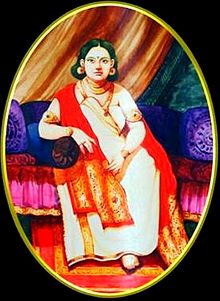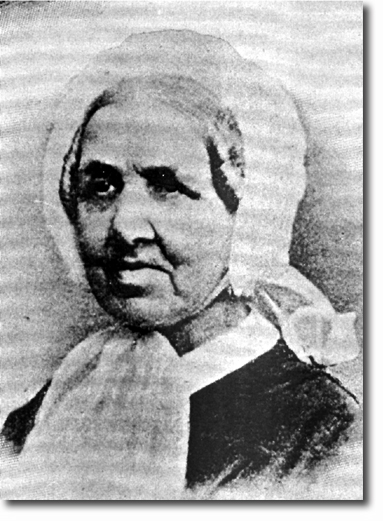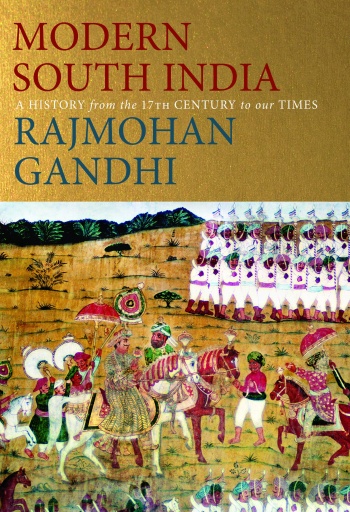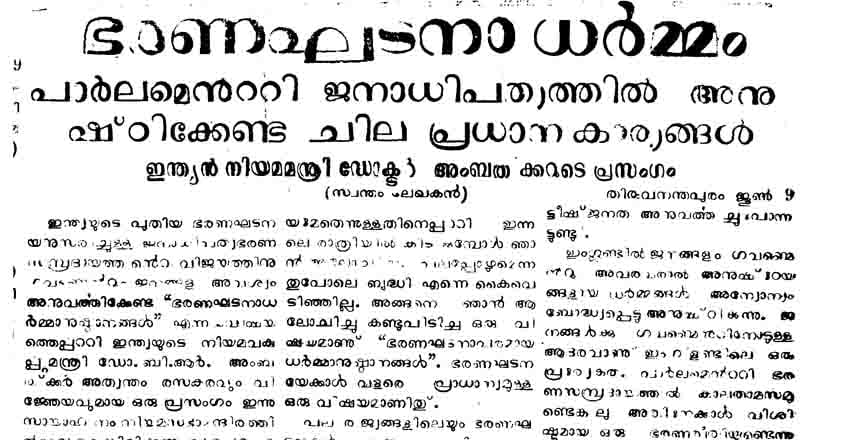The Synod held on 20-26 June 1599, was a turning point in the history of Syrian Christians in Kerala and in the history of the State as a whole. It created a huge fissure in communal harmony. Out of 18 priests from Angamaly, nobody attended this Synod. After this,the furious Arch Bishop of Goa, Dom Aleixo de Menezes (1559-1617), who convened the Diamper Synod, destroyed the library at Angamaly.
 |
| Aleixo de Mrenezes |
“Angamale was formerly the seat of the Archbishop of the Syrian churches in the Mountains of Malabar. In the town of Angamale there are three churches within a quarter of a mile from each other, in all of which service is still performed. The cathedral church is the largest, and contains the tombs of Bishops and Archbishops for many centuries. As I approached the town of Angamale in the evening, I heard the “sullen roar” of the great bell reverberating through the mountains. When the Romish Archbishop Menezes visited this place in 1599, the Christians strewed the way up the hill with the flowers as he advanced. And yet he came to burn the ancient libraries and Archives of Angamale. As the flame ascended, the old priests wept; but they were obliged to hide their tears, dreading the inquisition at Goa.”
Gouvea in Jornada (1603) also reports, that there was an archive attached to the Bishopric of Angamaly where the most important ecclesiastical documents were preserved. In Portuguese Christian documents, it could be seen that frequent usage of the word ‘serra’, meaning mountain region, which indicates the location of Angamaly.
As per folklore, Angamaly is considered to be the origin and main centre of Syrian Christians and from there it flourished entire Malabar (Kerala).There were Archdecons (head of community) and bishops residing at Angamaly.
The three ancient big Christian churches within a kilometere, located in a straight street, are unique and marvellous in the history of churches. It is recorded that the first church of Angamaly, dedicated to St. George, was used both by the catholics and Jacobites till 1750. In this church there was a chapel, which was dedicated to St. George, where both the Catholics and the Jacobites conducted their services in cordial manner, emerges the ecumenism between these two communities. The second church was the church of Hormisdas, the Cathedral church,which was either built or renovated by Mar Abraham, exclusively used by the Catholics.
It was in 1570s, that Mar Abraham started the construction work of this church of St.Hormisdas. Its earlier name Homusio was transformed to Hormisdas by Alexis Menezes. St.Hormisdas or St.Hormis Abbot was a Chaldean saint of the 7th century. He was a monk in the monastery of Robban Bar-Etha. At Angamaly, the Eastern Church (Cathedral church) was dedicated to his name. But the name of St. Hormis Abbot was replaced by St. Hormis, in the Udaympeur Synod (1599), Xth decree, by attributing St Hormis Abbot as Nestorian. The third church was dedicated to St. Mary, under Jacobite community.
In 9th century, when the old Crangannore town (Kodungalloor) was attacked by Mohammedans, the Christian inhabitants left Kodugallur and approached the Alangad King to inform their grievances. Tradition says that sometimes after the 9th century the Arabs set fire to Makodi and that the Christians fled to Angamaly which then became their Headquarters.
The King offered protection to them by developing a town and church exclusively for the colonial Syrian Christians concentrated at Angamaly. This church in the name of St Mary was handed over to Jacobite community which formed after Koonen Cross oath (1653) by splitting the Syrian Christian community in Malabar. It is believed that Angamaly was the main town or part of Makothavirapatnam. An argument is that, there was a community of Syrian Christians and the Archdeacons governed the civil matters of this community from 3rd century onwards, at Angamaly.
Even though Angamaly was the origin of Syrian Christian community and the first seat of Bishop House, there is no authentic evidence available about its generation period. In an account of a foreign missionary Fr. M.Karniarro who visited Angamaly in 1557, there is a narration about the establishments of a University for priests ( Malpan training) and a Christian church at Angamaly.
 |
| St George Basilica, Angamaly |
When in 1503 the Catholicos Elias V consecrated three Bishops for Christians in India, he conferred upon Mar Yahballaha the title, "The Metropolitan of India and China." The initialy good relationship of the East Syriac Christians to the Portuguese had gradually deteriorated, and the Portuguese sought to hinder the arrival of the new Bishops from Mesopotamia. Bishop Mar Dinkha had to flee inland in 1534. In 1558 the Latin Diocese of Goa was elevated to an Arch Diocese. At this time, basing his claim on a papal bull, John (Yuhannan) Sulaqa extended his jurisdiction over India. The East Syriac Catholicos Shimun VIII Dinkha finally opposed this action, consecrated Mar Abraham Bishop in 1557, and sent him to India. The influence of the Catholicos was still in force, though there were in India at this time East Syrian, Chaldean and Latin hierarchies operating in parallel. Since the colonial power Portugal had sponsored first the Latin and then the Chaldean Church, the direction of development during this time was clear. After the Haldean Bishop Mar Joseph was handed over to the Inquisition, Patriarch Abdisho IV named a new Metropolitan, who tried to come to an arrangement with Rome. He was,however recalled by the Pope.
In 1599,in order to avoid Schism, the so called Synod of Diamper was held under the leadership of Archbishop Menezes of Goa. There the decrees of the Council of Trent were declared binding,the Roman calendar introduced,and the liturgy revised on the Roman model. Nestorius was condemned as a heretic, and allegedly Hindu customs were forbidden.Under duress,150 priests and 660 laymen signed decrees stating that the Church of East India should be entirely subjected to Roman central authority.
 |
| Buchanan Bible at Cambridge |
The Infancy of our Saviour (The History of our Lady/Language: Syriac)
This book contained the following concepts, which are against Catholic creed:
- The annunciation of the angel was made in the Temple of Jerusalem, which contradicts the Gospel of St. Luke, which says it was made in Nazareth.
- Joseph had another wife and children when he was betrothed to Mary.
- Child Jesus was reproved for his naughty tricks.
- Child Jesus went to school and learned from them.
- St. Joseph, suspecting Mary of adultery, took her to priests, who gave her the water of jealousy to drink; that Mary brought forth with pain, and parting from her company, not being able to go farther, she retired to a stable at Bethlehem.
- None of the saints are in heaven but are all in a terrestrial paradise, where they should remain till the Day of Judgement.
Book of John Barialdan (Language: Syriac)
This book contained the following concepts which are against Catholic creed:
- In Christ, there were two persons: divine and human.
- The names Christ and Emmanuel are that of only the human person, so the name Jesus should not be adored.
- The union of incarnation is common to all the three divine persons, who were all incarnated.
- The union of the incarnation is only an accidental union of love.
The Procession of the Holy Spirit (Language: Persian)
This book contained the following concept which is against Catholic creed:
- The Holy Spirit proceeds only from the Father, and not from the Son.
Margarita Fidei (The Jewel)
This is written by Abed Isho, a Nestorian prelate. This book contained the following concepts which are against Catholic creed:
- Mary is not ought to be called the mother of God, but only the mother of Christ.
- In Christ there are two persons, the one of the Word, and the other of Jesus.
- The union of the incarnation is only an accidental union of love and power and not a substantial union.
- Out of three distinct faiths Nestorian, Jacobite, and Roman, only the Nestorian faith is the true one taught by the Apostle, and the Roman faith is false and heretical.
- Matrimony is not a sacrament.
- The fire of hell is metaphorical, not real.
- Roman Church is fallen from the faith as they do not celebrate in leavened bread.
Fathers (Language: Unknown)
This book contained the following concepts which are against Catholic creed:
- Mary ought not to be called the mother of God.
- The Patriarch of Nestorians is the universal head of the Church immediately under Christ.
- The fire of hell is not real, but spiritual.
- It is heresy to say God was born, or died.
- There are two persons in Christ.
Life of Abed Isho (Language: Arabic)
This book contained the following concepts which are against Catholic creed:
- The whole Trinity was incarnated.
- St. Cyril of Alexandria, who condemned Nestorius, was a heretic and is now in hell, for having taught, that there is only one person in Christ.
- Nestorius, Theodoras and Diodorus are saints and are blessed.
- None of the saints are in heaven but are all in a terrestrial paradise, where they should remain till the Day of Judgement.
- God dwelt in Christ as in a rational temple, giving him the power to do all the good things he did.
- The souls of the just will be in a terrestrial paradise till the Day of Judgement.
Book of Synods (Language: Syriac)
It contains a forged letter of Pope Caius, with false subscriptions of many other Western Bishops, directed to Nestorian Bishops, wherein it is acknowledged that the Church of Rome ought to be subject to Nestorian church.
This book contained the following concepts which are against Catholic creed:
- The Roman Church is fallen from the faith, having perverted the canons of the Apostles, by the force of heretical emperors' arms.
- The Romans are heretics, for not celebrating in leavened bread.
- All Bishops who followed Nestorius ought to be much esteemed and styled saints and their relics must be revered.
- Matrimony is not a sacrament. It may be dissolved for the bad conditions of the parties.
- Usury is lawful, and there is no sin in it.
Book of 'Timothy the Patriarch' (Language: Persian)
This book contained the following concept which is against Catholic creed:
- That the true body of our Lord Christ is not there in the sacrament of the altar, but only its figure.
Domingo or Letter of the Lord's-day (Language: Malayalam)
A letter believed to have come from heaven, in which the Roman Church is accused of having fallen from the faith.
Maclamatas (Language: Syriac)
It claims the distinction of two persons in Christ, and the accidental union of the incarnation is proved.
Uguarda or Rose (Language: Greek)
This book contained the following concepts which are against Catholic creed:
- There are two persons in Christ.
- The union of the incarnation was accidental.
- When Mary brought forth with pain, the sons of Joseph, which he had by his other wife, went for a midwife to her.
Camiz (Language: Syriac)
This book contained the following concept which is against Catholic creed:
- The Divine Word and the Son of the Virgin Mary are not the same.
Menra (Language: Hebrew)
This book contained the following concepts which are against Catholic creed:
- Christ is only the image of the Word.
- The substance of God dwelt in Christ as in a temple.
- Christ is next to the divinity and was made the companion of God.
Book of Orders (Language: Tamil)
This book contained the following concepts which are against Catholic creed:
- The form, and not the matter, is necessary to orders.
- There are only two orders: diaconate and priesthood.
- Altars of wood, and not of stone, are to be consecrated.
It also contains prayers for those converted to Nestorianism from any other sect.
Book of Homilies (Language: Arabic)
This book contained the following concepts which are against Catholic creed:
- The Eucharist is only the image of Christ and is distinguished from him, as an image is from a true man.
- The body of Jesus Christ is not there in Eucharist, nor anywhere else but in heaven.
- The whole Trinity was incarnate.
- Christ is only the temple of the Divinity, and God only by representation.
- The soul of Christ descended not into hell but was carried to the paradise of Eden.
It also contains:
- Letters from some Nestorian synods, in which it is said that the Nestorian Patriarch is not subject to the Roman Bishop.
- An oath to be taken to the Nestorian Patriarch, as the head of the church, wherein people swear to obey him, and him only, and not the Bishop of Rome.
An Exposition of the Gospels (Language: Syriac)
This book contained the following concepts which are against Catholic creed:
- There are two persons in Christ.
- Christ is a pure creature.
- He was obliged to adore God, and stood in need of prayer.
- He was the temple of the holiest Trinity.
- Christ's soul, when he died, descended not into hell, but was carried to the paradise of Eden.
- Mary deserved to be reproved as well as the rest of the Jews for having vainly imagined that she was mother to one that was to be a great King; looking upon Christ as no other than a pure man and presuming that he was to have a temporal empire.
- Evangelists did not record all Christ's actions in truth as they were not present at many of them.
- The wise men that came from the East received no favor from God for their journey, neither did they believe in Christ.
- Christ was the adopted Son of God, and not God's natural Son.
- Christ received new grace in baptism, which he had not before.
- Christ is only the image of the Word and the pure temple of the Holy Spirit.
- Eucharist is only the image of the body of Christ, which is only in heaven at the right hand of the Father, and not here on earth.
- Christ, as pure man, did not know when the Day of Judgement was to be.
- When St. Thomas put his hand into Christ's side, and said, "My Lord and my God!" he was not speaking to Christ as God, but it was only an exclamation made to God on such a miracle.
- The authority that Christ gave to St. Peter over the church was the same that he gave to other priests, so his successors have no more power or jurisdiction than other bishops.
- Mary is not the mother of God.
- The First Epistle of St. John, and that of St. James, are not the writings of those Apostles, but of some other persons of the same name, and therefore are not canonical.
Book of Hormisda Raban (Language: Greek)
This book contained the following concepts which are against Catholic creed:
- Nestorius was a saint and martyr and suffered for the truth.
- St. Cyril, who persecuted him, was the priest and minister of the devil and is now in hell.
- Images are filthy and abominable idols, and ought not to be adored.
- St. Cyril, as a heretic, invented and introduced them.
Book of Lots (Language: Aramaic)
It contains many non-Christian rituals and practices such as:
- Ring of Solomon
- Choice of good days to marry upon, and for several other uses.
A book of unknown title which is a Nestorian version of Flos Sanctorum (Language: Syriac)
Describes the lives of many Nestorian saints.
Parisman or Persian Medicine (Language: Persian)
It contains:
- Many sorceries.
- Certain methods whereby one may do mischief to their enemies and may gain women.
- The strange names of devils, that whosoever shall carry the names of seven of them about him writ in a paper shall be in no danger of any evil.
- Many exorcisms for the casting out of devils, mixing some Christian words with others that are not intelligible.
- The invocation of the Most Holy Trinity, often desiring the doing of lewd things and enormous sins, joining the merits of Nestorius and his followers, many times, in the same prayer with those of the Blessed Virgin, and those of their devils with those of the holy angels.
The decree XVI ordered that all the Syriac MSS should be handed over to the Archbishop or his deputy on a visit to the Churches. Due to the lack of printed books, the Qurbana MSS were excluded from this.Some of the other books which are said to have been burnt at the Synod of Diamper are:
- The book of the infancy of the savior (history of our Lord)
- Book of John Brandon
- The Pearl of Faith
- The Book of the Fathers
- The Life of the Abbot Isaias
- The Book of Sunday
- Maclamatas
- Uganda or the Rose
- Comiz
- The Epistle of Mernaceal
- Menra
- Of orders
- Homilies (in which the Eucharist is said to be the image of Christ)
- Exposition of Gospels
- The Book of Rubban Hormisda
- The Flowers of the Saints
- The Book of Lots
- The Parsimony or Persian Medicines.
After the Synod of 1599, clerics of the Syrian Church were advised to bring their religious texts to correct the errors in their Bible. All the copies of the Syrian Bible were declared heretical and ordered to be burnt. Before the Church had time to react,they were destroyed. This was followed by the destruction of the huge library of the Syrian Church at Angamaly. Only a single copy of the Syriac Bible survived in a remote church in central Malabar. In 1807 when Buchanan was in Kerala,Mar Dionysius showed this copy to him. The Church gifted it to Buchanan. He donated it to the University of Cambridge in 1809.
It is believed that, by a quirk of fate, only a single manuscript of the Syriac Bible survived. K R N Swamy in his book, Mughals, Maharajas and Mahatma, writes how the invitation to the Synod had not reached one of the remote mountain churches in Central Malabar, where this Bible was kept.
 |
| F Ros monument,St Thomas Church,N Parur |
After the Synod, the Syrian Christians became a filial church of the Latin Church, and their connection with the Catholicos was severed. 1599 is portrayed as the darkest year of Indian church history. It is nevertheless typical that the Jesuit F Roz, who eventually became the Latin hierarch of the Syrian Christians from 1599 to 1624, reached the conclusion: "These Christians are certainly the earliest in this part of the Orient...Although they have lived under the heathens, Jews and Mohammedans, they have remained steadfast in their faith to this day."
Mar Abraham died in January, 1597 at Angamaly and his body was buried in the Cathedral church (St. Hormis or East church, Angamaly). Angamaly was the first Archdiocese in India and the jurisdiction of the Angamaly at that time, extended over the whole of India, and the metropolitans were designated as ‘of India’ or ‘all India’ ( metropolita w- tha’ rad-kollah hendo). After Mar Abrham’s demise, the superior of Archdiocese, Goa, Menezes degraded Angamaly and brought it under the control of Goa Archdiocese by appointing Fr. Francisco Ros as Bishop of Angamaly.
The disgraceful activities of Menezes, enraged the Syrian Christians of Angamaly. They struggled to recapture the lost Archdiocese seat of Angamaly. The Archdeacon Geevarghese also, with the support of native Christian community, protested against the biased movements of Menezes. In addition, there was a strong power of Nazarani soldiers under Archdecon. It is very interesting to review the past history of these soldiers, who were trained in different types of fights, centered at Angamally. There were more than fifty thousand trained Nazarani soldiers (belongs to ‘Amoci’ or ‘Chaver’ – were persons who swore to give their lives to protect a person) who were ready to serve the local rulers and also to take care of Syrian Christians. Menezes tried to convene a Synod to establish his interests without obtaining permission from Rome. But he was not daring to organize this Synod at Angamaly as it was the dominant center of Syrian Christians and Nazrani soldiers. So he selected a safe place to conduct this ‘Angamaly Synod’ at Udayamperur where he managed to get the support of king of Kochi and Portuguese soldiers.
Thus the synod was held at Udayamperur in 1599.
The Jesuits started a seminary at Vaippicotta in 1581 for Syrian Christians. Fr. Francis Roz was the Rector and he taught Syriac in 1584. The excellent teaching in the seminary really attracted the Syrian Christians and they sent their children to it. It was under the jurisdiction of Mar Abraham (1567-'97), bishop of the Syrian Christians. This seminary became very famous. It was staffed by the Jesuits. There were 50 or 60 students who were taught the Humanities, Latin, Chaldean, the Cases of conscience, the rudiments of catholic faith and of the liturgy.
In 1627, the yogam (assembly) at Edapally decided to suppress Malpanates and to give instructions to send the students to Vaipicotta seminary. The following directions were given to the seminary : To limit the number of admissions to Vaipicotta seminary To select candidates from noble families To select only the best to priesthood To teach others to live as good Christians Regarding the piety and exemplary life of the students of this seminary, there is a report of 1597. They increase more and more every day in number as well as in diligence to piety. Every fifteen days they receive the sacraments, sometimes more frequently. They do various penances and fasts. They are taught Syriac and Latin. They recite prayers at fixed hours every day. They speak about divine things with ardour.
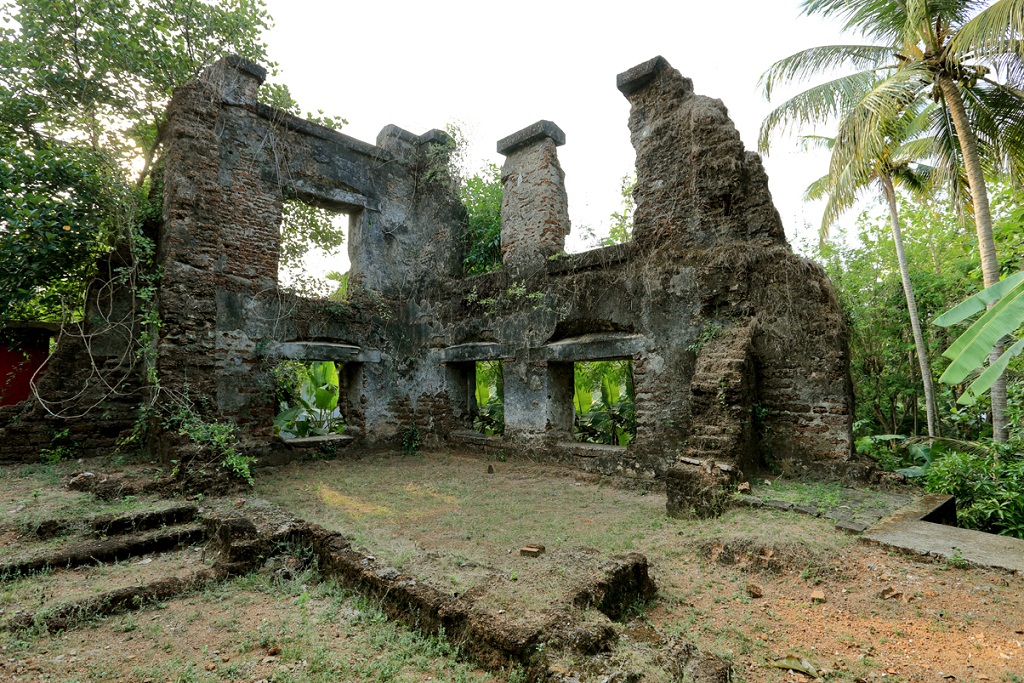 |
| Ruins of Vypikotta Seminary |
Over the course of this invasion, many Syrian Malabar Nasranis were killed or forcibly converted to Islam. Most of the coconut, arecanut, pepper and cashew plantations held by the Syrian Malabar farmers were also indiscriminately destroyed by the invading army. As a result, when Tipu's army invaded Guruvayur and adjacent areas, the Syrian Christian community fled Calicut and small towns like Arthat to new centres like Kunnamkulam, Chalakudi, Ennakadu, Cheppadu, Kannankode, Mavelikkara, etc. where there were already Christians. They were given refuge by Sakthan Tampuran, the ruler of Cochin and Karthika Thirunal, the ruler of Travancore, who gave them lands, plantations and encouraged their businesses. Colonel Colin Maculay, the British resident of Travancore also helped them.
 |
| Mural of St Thomas/St Mary's Church |
In around 1193 CE, Muhammad bin Bakhtiyar Khilji, a Turkic chieftain out to make a name for himself, was in the service of a commander in Awadh. The Persian historian, Minhaj-i-Siraj in his Tabaqat-i Nasiri, recorded his deeds a few decades later. Khilji was assigned two villages on the border of Bihar which had become a political no-man's land. Sensing an opportunity, he began a series of plundering raids into Bihar and was recognised and rewarded for his efforts by his superiors. Emboldened, Khilji decided to attack a fort in Bihar and was able to successfully capture it, looting it of a great booty. Minhaj-i-Siraj wrote of this attack:
"Muhammad-i-Bakht-yar, by the force of his intrepidity, threw himself into the postern of the gateway of the place, and they captured the fortress, and acquired great booty. The greater number of the inhabitants of that place were Brahmans, and the whole of those Brahmans had their heads shaven; and they were all slain. There were a great number of books there; and, when all these books came under the observation of the Musalmans, they summoned a number of Hindus that they might give them information respecting the import of those books; but the whole of the Hindus had been killed. On becoming acquainted [with the contents of those books], it was found that the whole of that fortress and city was a college, and in the Hindui tongue, they call a college [مدرسه] Bihar."
 |
| Ruins of Nalanda University |
1.The Church of the East: A Concise History/ Wilhelm Baum, Dietmar W. Winkler
2.Travancore Resident G T Mackenzie's Chapter on Christianity,dated 23 October 1901 to V Nagam Aiya's Travancore Manual


